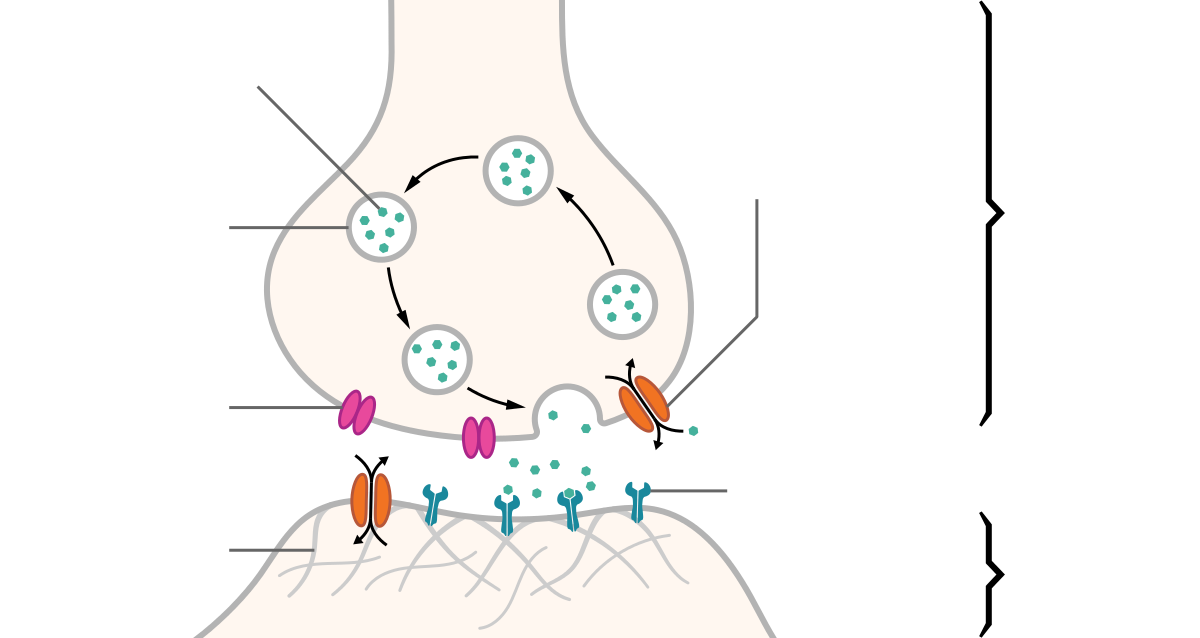 |
| You can try to identify the structures |
Synapses resemble a basic conversation between two individuals and of course, leave room for other people to enter. Person A tells something to Person B and because they speak the same language and the two are healthy individuals, the message is delivered to the receptor who may say the same thing to Person C or something as a result of the previously received information. But for our brains, the two persons are representations of two neurons and the language is
a combination of electrical events and neurotransmitter release at synapses...the connections between nervous cells. Things are actually more complicated than they look yet interesting, nonetheless. Just as a person might speak louder and have a bigger impact on the other, a radio might do the same. In this case, the radio is a drug designed to act at the level of a synaptic cleft, on the pre-synaptic or post-synaptic membrane. I find synapses fascinating... and awesome enough to dedicate them a post: a classification and an explanation of how neurons use them.
Types of synapses:
Chemical synapses are characterized by a larger gap of 20 nm (the synaptic cleft) and the presence of neurotransmitter molecules which act on protein receptors. When a message is received it is transformed into an electrical event and when it reaches the axon's end it leads to the fusion of vesicles with the pre-synaptic membrane and the release of neurotransmitter molecules. An easier way to understand is to see the whole sequence as if Person A tells something to Person B: Person A knows what he or she wants to say and conveys the information in the form of language. As the message travels, you can think of this route as the electric propagation across the axon. When Person B understood the message, the neurotransmitter molecules would have acted on the post-synaptic membrane( which is part of Person B). Check out the drawing below.
Electrical synapses involve narrower gaps (gap junctions) of 2.5-3.5 nm and the direct transmission of an electrical impulse. Interesting facts about these types which are also found in the myocardium I read in an article in Scientific American: it's interesting how frequently the components of the gaps are taken down and replaced and how they behave in case of tissue damage. Without going into much detail, it's easier to look at the two connected cells as glued to each other at microscopic level; because of this connections the flow of ions between the adjacent cells ensures the depolarization of the second and so a new action potential=electric event. While in the case of chemical synapses Person B had to wait for the neurotransmitter molecules to act, for electrical synapses Person B understood the message more rapidly.It is like Person B read the mind of Person A for they are glued to each other.
How neurons communicate despite of the synapse type:
I mentioned above that there is an electric propagation of an action potential across the axon of a neuron. And the information is passed between nervous cells as action potentials which are electric events. To get a grasp of what is actually happening, you need to know that the movement of ions and the activity of ion channels and pumps has to do with these events. The main ions in this case are Na, K and Cl. The comfort zone or resting potential of a neuron would be easily described as positive on the outside and negative on the inside and is usually maintained by the activity of the Na/K pump which takes Na ions out of the neuron and K ions in. Cl ions are also present and help ensure the negative surrounding. When a stimulus hits a neuron it may cause the Na channels to open up for long enough so that the ions pass inside the axon and as a result, lead to the depolarization of the membrane( and the generation of an action potential). Here, depolarization does not have to be complicated, it generally means that at a specific point along the axon the inside becomes positive in respect to the outside environment. The propagation of the action potential along the membrane changes the charge of the intracellular environment in respect to the outside. As the potential reaches the synaptic cleft it makes the Ca channels (which are depicted in the images) to become sensitive, leading to an inflow of Calcium. Owing to this event, the neurotransmitter vesicles fuse with the membrane and release their content in the synaptic cleft. When the molecules reach the post synaptic membrane by diffusion they log on to their receptors and cause depolarization or hyperpolarization. In the case of the latter, no impulse or action potential is generated=> for the information to travel further and have an effect you would look for the depolarization of the membrane of the second neuron. For electric synapses, things are not that complex (they are actually but that's not the point of this post, is it?). Due to the gap junction the flow of ions that causes depolarization in the first neuron is passed to the second- just the flow of particles is enough.
All in all, there are two types of synapses in the nervous system and they both facilitate the transmission of electric impulses between cells. Moreover, the spread of the electrical impulse along the axon of a neuron is the same regardless of the synapse type it uses to connect with another cell.

No comments:
Post a Comment